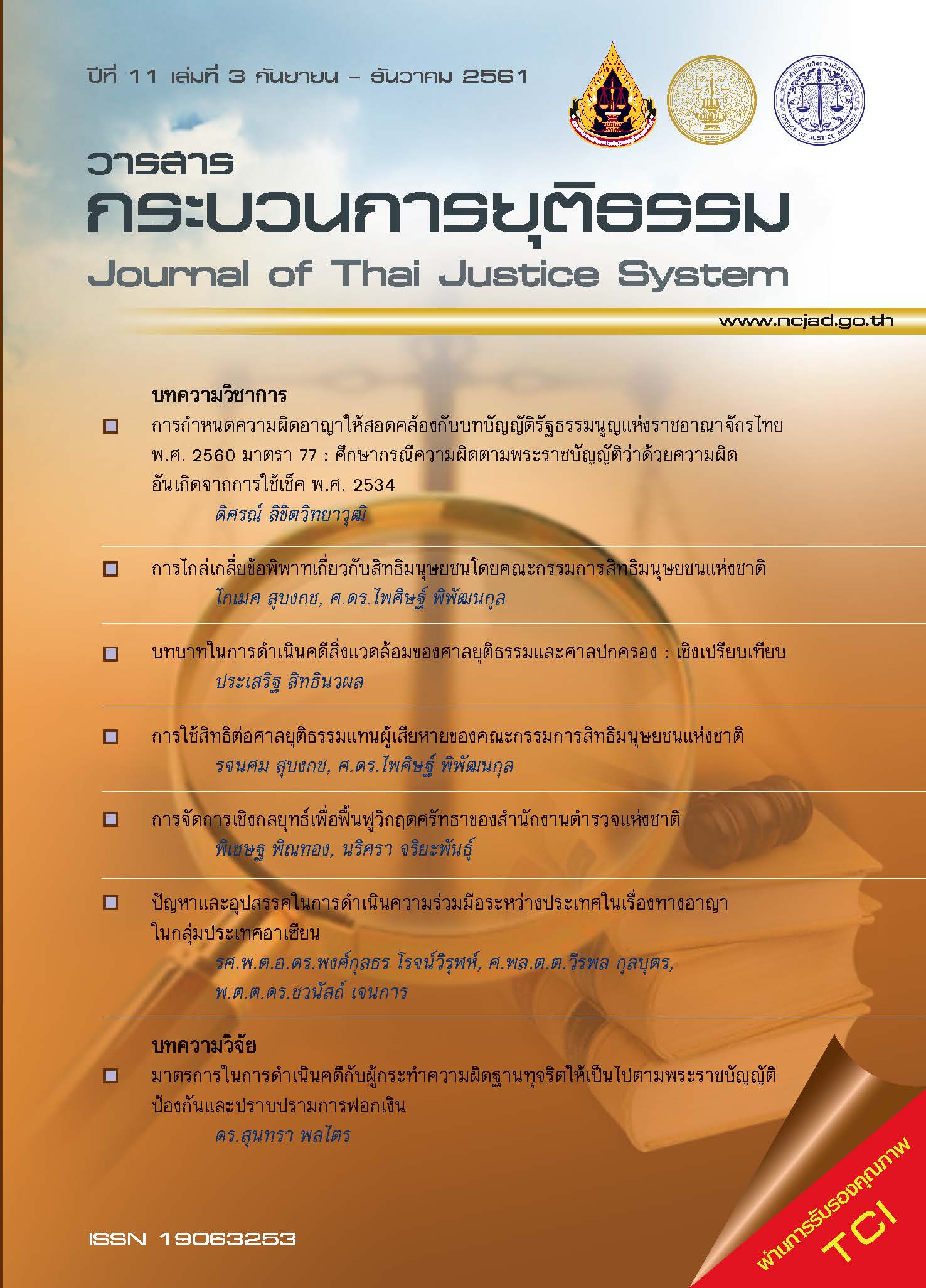มาตรการในการดำเนินคดีกับผู้กระทำความผิดฐานทุจริตให้เป็นไปตามพระราชบัญญัติป้องกันและปราบปรามการฟอกเงิน
Main Article Content
บทคัดย่อ
การวิจัยนี้มีวัตถุประสงค์เพื่อ (1) ศึกษามาตรการในการดำเนินคดีกับผู้กระทำความผิดฐานทุจริตให้เป็นไปตามพระราชบัญญัติป้องกันและปราบปรามการฟอกเงิน(2) ศึกษาแนวทางในการวางมาตรการการทำงานของหน่วยงานที่เกี่ยวข้องกับการบังคับใช้กฎหมายในคดีความผิดฐานทุจริต
การวิจัยเชิงคุณภาพ โดยการวิจัยเอกสาร พระราชบัญญัติป้องกันและปราบปรามการฟอกเงิน ระเบียบ กฎกระทรวงที่เกี่ยวข้อง รายงานการศึกษา ผลการวิจัยเกี่ยวกับการป้องกันและปราบปราม
การฟอกเงินและสัมภาษณ์เชิงลึกผู้บริหารและผู้ปฏิบัติงานในหน่วยบังคับใช้กฎหมายที่เกี่ยวข้องกับ
การดำเนินคดีกับผู้กระทำความผิดฐานทุจริตและภาคเอกชนที่มีส่วนร่วมในการต่อต้านการทุจริต
ผลการศึกษาพบว่ามาตรการดำเนินคดีกับผู้กระทำผิดฐานทุจริตจะมีประสิทธิผล และประสิทธิภาพได้นั้นควรมีการบูรณาการการทำงานของหน่วยงานที่เกี่ยวข้องคือมีการดำเนินคดีใน 3 มิติ ไปพร้อมกัน มิติที่ 1 คดีอาญาหลักหรือคดีมูลฐาน มิติที่ 2 มาตรการทางแพ่ง มิติที่ 3 มาตรการทางอาญา (การดำเนินคดีอาญาฟอกเงิน) การดำเนินการทั้ง 3 มิติจะแตกต่างกันในขั้นตอนแรก เมื่อมีการกระทำความผิดเกิดขึ้น พนักงานเจ้าหน้าที่ที่มีอำนาจตามกฎหมายแห่งการกระทำความผิดนั้น จะเป็นผู้ดำเนินการสืบสวน สอบสวน รวบรวมพยานหลักฐาน จนกระทั่งส่งเรื่องให้พนักงานอัยการ เมื่อถึงขั้นตอนนี้เป็นอำนาจหน้าที่ของพนักงานอัยการยื่นฟ้องต่อศาล จะเห็นได้ว่าในขั้นตอนนี้คดีทั้ง 3 มิติ พนักงานอัยการเท่านั้นมีอำนาจดำเนินการยื่นคำร้อง คำฟ้องคดีต่อศาลให้พิจารณาพิพากษา
การดำเนินคดีกับผู้กระทำผิดฐานทุจริตให้เป็นไปตามเจตนารมณ์ของพระราชบัญญัติป้องกันและปราบปรามการฟอกเงิน ที่มุ่งเน้นการตัดวงจรการกระทำความผิดที่เกิดจากการนำเงินสกปรก
ที่ฟอกแล้วกลับไปใช้ในการกระทำความผิดอีกครั้งนั้น ควรมีการนำหลักธรรมาภิบาล โดยเฉพาะด้าน
ความคุ้มค่า และทฤษฎีการปฏิบัติการของบูดิเยอร์เกี่ยวกับการสร้างยุทธศาสตร์ของหน่วยงานภาครัฐ
มาบูรณาการการทำงานในการดำเนินมาตรการทางแพ่ง และมาตรการทางอาญากับผู้กระทำผิดฐานทุจริต อันจะช่วยลดขั้นตอน และเสริมสร้างความร่วมมือในการดำเนินคดีระหว่างหน่วยงานที่เกี่ยวข้อง และมีข้อเสนอที่สำคัญในส่วนของมาตรการทางแพ่ง เห็นควรมีการแก้ไขกฎหมายเพิ่มเติมในพระราชบัญญัติป้องกันและปราบปรามการฟอกเงินให้พนักงานเจ้าหน้าที่ สำนักงาน ปปง.ที่มีคุณสมบัติตามที่กำหนด
เป็นผู้มีอำนาจหน้าที่ยื่นคำร้องในการดำเนินการกับทรัพย์สินที่ยึดหรืออายัดต่อศาลแทนพนักงานอัยการ
เพื่อเป็นการลดภาระทางคดีที่มีจำนวนมากและทำให้เกิดความคล่องตัว สามารถจัดการกับทรัพย์สิน
ที่เกี่ยวกับการกระทำผิดได้อย่างทันท่วงที
Article Details
ต้นฉบับที่ได้รับการตีพิมพ์ในวารสาร เป็นลิขสิทธิ์ของวารสารกระบวนการยุติธรรม แต่ความคิดเห็นที่ปรากฏในเนื้อหาของบทความในวารสารกระบวนการยุติธรรม ถือเป็นความรับผิดชอบของผู้เขียนแต่เพียงผู้เดียว
เอกสารอ้างอิง
จำแลง กุลเจริญ. (2537, กรกฎาคม - สิงหาคม). กฎหมายป้องกันการฟอกเงิน. ดุลพาห. 41(4). 15-27.
ทักษอร สุวรรณสาย, (2551). พระราชบัญญัติป้องกันและปราบปรามการฟอกเงิน พ.ศ. 2542: ศึกษากรณีอำนาจในการรวบรวมพยานหลักฐานของพนักงานเจ้าหน้าที. (วิทยานิพนธ์ปริญญามหาบัณฑิต,จุฬาลงกรณ์มหาวิทยาลัย). สืบค้นจาก http://tdc.thailis.or.th/tdc/browese.php?option=show&browes_type=titile&titleid=116359.
รัชยา ภักดีจิตต์. (2555). ธรรมาภิบาลเพื่อการบริหารภาครัฐและภาคเอกชน. จุฬาลงกรณ์ มหาวิทยาลัย, 22


